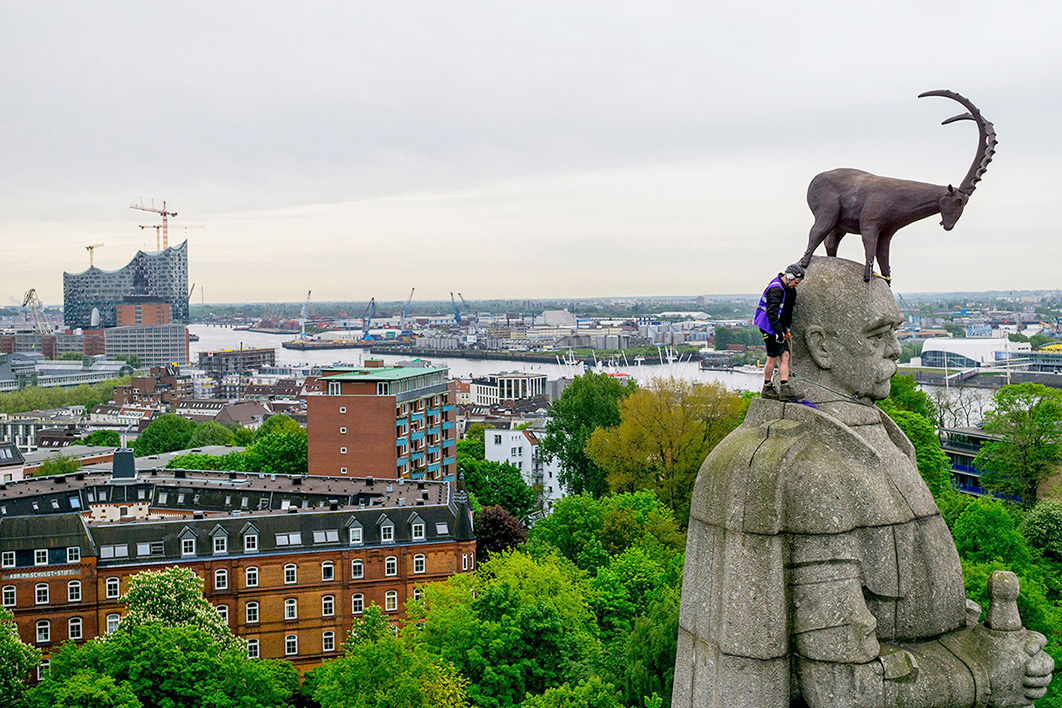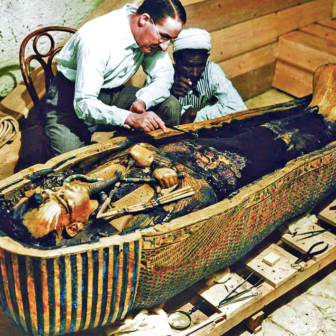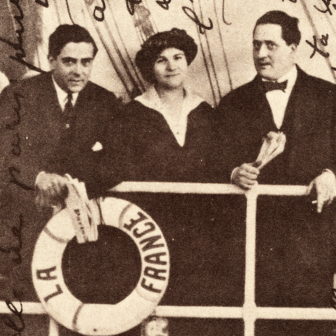Writing recently in the Hamburg broadsheet Abendblatt, deputy editor-in-chief Matthias Iken evoked the world of George Orwell’s Nineteen Eighty-Four. “Anything that doesn’t conform to currently valid ‘truths’ is to be silenced,” he fumed. Using an English term that has lately entered the German lexicon, he added: “Apparently Hamburg is about to become the capital of this ‘cancel culture.’” Iken’s ire had been raised by a seemingly trivial matter: the district assembly of Hamburg-Nord’s reversal of its decision last year to name a small square in Hamburg after Emily Ruete, who migrated to Germany in the nineteenth century.
Born Salama bint Said in 1844 in Zanzibar, she was the daughter of Said bin Sultan Al-Said, the Sultan of Zanzibar and Oman, and Jilfidan, a Circassian woman who had been abducted by slave traders as a child and bought by the sultan to join his harem. Although her mother was not the sultan’s principal wife, Salama benefited from being part of the island’s ruling family. As one of her father’s thirty-six children, she inherited a plantation and residence upon his death, and a further three plantations when her mother died.
In her early twenties, Sayyida Salme (Princess Salama), as she was later known, was living in the Zanzibar capital, Stone Town. A love affair with her neighbour, the German merchant Rudolph Heinrich Ruete, resulted in her falling pregnant. Conscious that her relatives wouldn’t countenance marriage to an infidel, she fled to Aden aboard HMS Highflyer with the help of the wife of a British consular official. There she converted, took the name Emily and married Ruete, who had followed her under less dramatic circumstances. The couple moved to Rudolf Heinrich’s native Hamburg, where they had three more children (her first child had died in Aden). The marriage was short-lived, however; in 1870, aged thirty-one, Rudolph Heinrich was killed in a tram accident.
Although Hamburg law prevented Emily Ruete from claiming her late husband’s estate, she and her children initially remained in Germany — not least because her return to Zanzibar was vetoed by her half-brother, the then sultan. Occasionally she taught Arabic to make ends meet. In 1886 she published a part memoir, part ethnography of Zanzibar, Memoiren einer arabischen Prinzessin, that would be reprinted numerous times and translated into English (under the title Memoirs of an Arabian Princess), French, Arabic and other languages. In 1889 she left Germany and settled in Beirut. When the first world war broke out, she returned to Germany to live with one of her daughters in Jena, where she died in 1924.
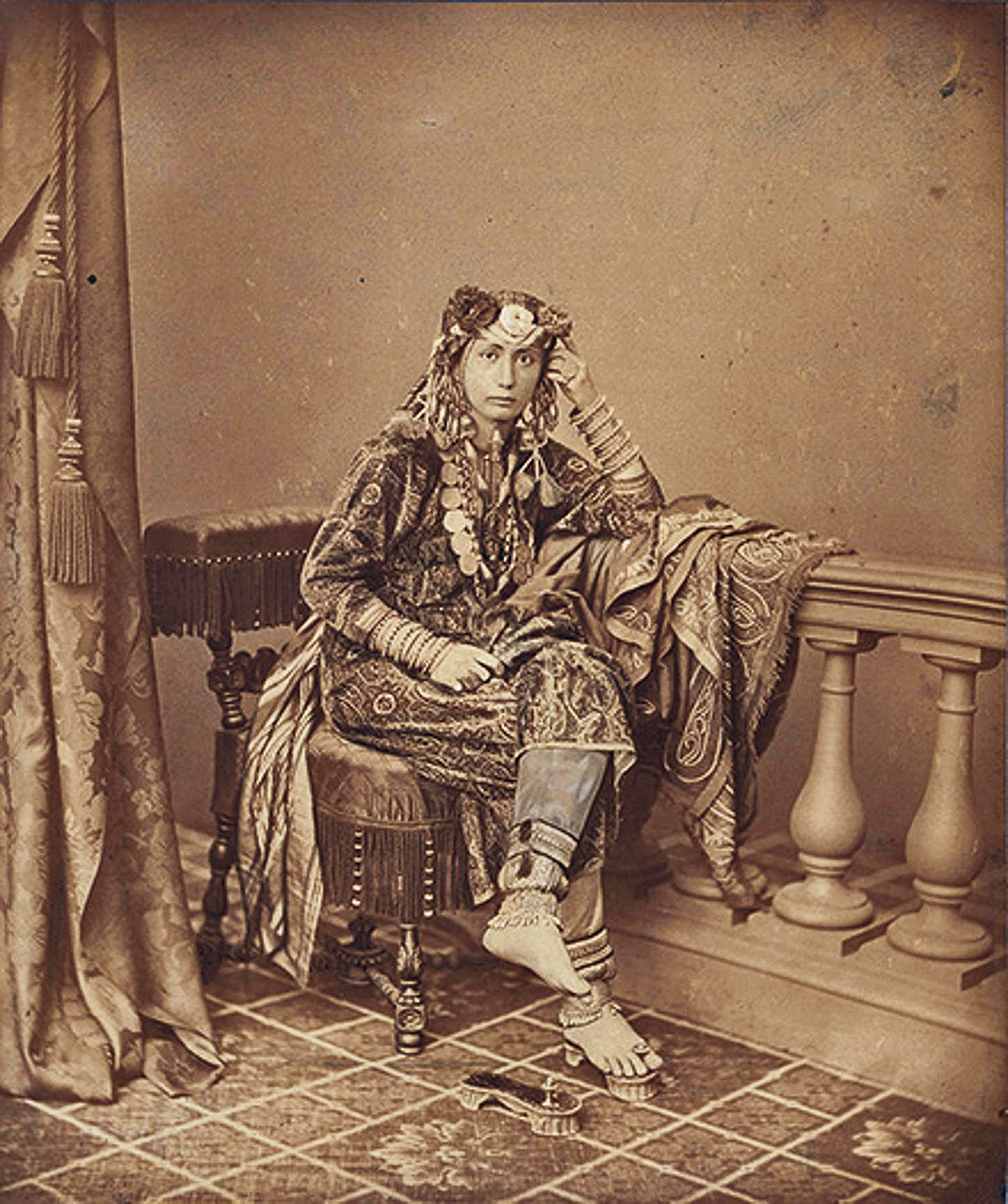
“Model immigrant”: Emily Ruete (Sayyida Salme), Princess of Zanzibar. Undated photo by unknown photographer/Alamy
Emily Ruete was buried in her husband’s family plot in Ohlsdorf, Hamburg’s main cemetery. The grave is considered historically significant and has been preserved. In 2007, during the European Year of Equal Opportunities for All, her life was commemorated with a memorial in the cemetery’s Garden of Women. Two years later, her story featured in an exhibition at Hamburg’s town hall. Over the past twelve years, her life has also been the subject of three works of fiction: the rather conventional biographical novels Sterne über Sansibar (2011) by Nicole Vosseler and Abschied von Sansibar (2013) by Lukas Hartmann, and Sansibar Blues (2008), a piece of postcolonial metafiction by acclaimed writer Hans Christoph Buch.
Given this background, it’s not surprising that a local resident suggested naming a park in Hamburg-Nord, one of Hamburg’s seven districts, after Emily Ruete. In a submission to the district assembly five years ago, he argued that the park, adjacent to a waterway and not far from a mosque and the Ruetes’ former residence, was reminiscent of Zanzibar. The idea was again on the assembly’s agenda in 2017, this time supported by the argument that present-day refugee movements made it appropriate to honour “Emily Ruete aka Princess Salme” as a “model immigrant of her time.” On neither occasion did the idea attract sufficient backing.
Events started to move more quickly in February last year. A newly created square needed a name, and this time the Social Democrats and the Greens, who together hold the majority of seats in the assembly, proposed memorialising Ruete, with the Greens arguing that she was a “strong and intriguing” historical figure. Local residents attending the meeting at which the plan was considered commented that the name didn’t matter to them; they were more concerned that street furniture be installed to make the square more inviting. When the motion was put to a vote, the Christian Democrats opposed it — not because they objected to memorialising Ruete, but because they believed the process of naming the square lacked transparency.
Later last year, Hamburg-Nord Council advised the district assembly that the square’s name had been gazetted and street signs delivered. The council suggested that an information panel about Ruete’s life be erected and her descendants invited to attend its unveiling, and in February 2020 €4400 (A$7200) was allocated to commissioning a local history workshop to create the panel.
Here, the story took its controversial turn. The workshop’s research found that Ruete had not only defended slavery during her lifetime but also made racist remarks in her 1886 memoir. The workshop’s findings drew on an intervention by a member of Hamburg Postkolonial, a network of individuals interested in Hamburg’s colonial legacy, who may well have been the first person to take an interest in the naming of the square and read Ruete’s 1886 book closely.
In September this year the Greens and the Social Democrats moved successfully to reverse the assembly’s earlier decision. “In 2020, to name a square after Emily Ruete is not an option,” the minutes of the meeting record a Greens representative saying. “It would be inconsistent with the [two parties’] stance against exclusion and inhumanity.” Rather than naming the square after someone else, the district assembly decided to leave it nameless for the time being, presumably to avoid having Ruete’s name remain in place during the search for a substitute. Immediately after the assembly’s decision, council workers removed the offending street signs.
Matthias Iken and others who criticised the change of heart bemoaned the fact that a nineteenth-century woman was being judged against the standards of the twenty-first century. A representative of the Free Democratic Party, who voted against the unnaming of the square, argued that Ruete’s book was “an authentic non-European source” about the history of East Africa, which had otherwise been told from a “colonial point of view.” Ruete had commented on the Germany of the time from a non-European perspective, he pointed out, and had exposed the hypocrisy of her European contemporaries in Zanzibar, who decried the institution of slavery but were themselves slave owners.
By the time Ruete’s book was published, slavery had long been formally abolished in Europe and North America: in Britain, for instance, in 1834; in France in 1848; and in the United States in 1865. But Emily Ruete, herself the daughter of a former slave, had known Zanzibar only as a place where slavery was largely uncontested. In the mid nineteenth century, the island had been a hub of the Arab slave trade, with possibly as many as 50,000 slaves passing through its port annually. The political clout of Emily Ruete’s father, the sultan, was based not least on his prominent involvement in that trade. Slavery was formally abolished in Zanzibar in the 1870s but continued until the early twentieth century, despite the island’s becoming a British protectorate in 1890.
The September 2020 backflip was not the first time Hamburg politicians have had second thoughts about streets named after people whose views or deeds are now considered repugnant. In recent years, Hamburg’s state government has become particularly concerned by the possibility that some streets and public buildings might be named after people who were Nazis, supported the Nazis or advocated anti-Semitic or racist ideas.
In several instances, streets have been renamed; on two occasions their names were retained but the reference changed. Weygandt Street, for example, was originally named after the Hamburg psychiatrist Wilhelm Weygandt (1870–1939), who was interested in eugenics and sympathised with the Nazis. Now it is named after somebody with no connection to Hamburg: Friedrich Weygandt, a public official in Mainz who was executed because he had been a vocal critic of the local archbishop during the peasants’ war of 1525. New proposals for street names are now routinely vetted by the Hamburg State Archives.
In 2017, the archives commissioned historian David Templin to investigate fifty-eight historical figures whose names featured on street signs, or were likely to do so sometime soon, and develop criteria for deciding whether to rename particular streets. One person on the list was Gustav Gründgens, a famous actor and director whose life is explored in Klaus Mann’s controversial novel Mephisto and the acclaimed István Szabó film of the same name, winner of the 1981 Oscar for the best foreign-language film. So far Gründgens, who was the protégé of Nazi strongman Hermann Göring and played a prominent role in Nazi Germany’s cultural life, has not been deemed sufficiently compromised to warrant a renaming of the street carrying his name.

Compromised? Gustav Gründgens as Hamlet in January 1936. Wikimedia
While until very recently the archives’ vetting process focused on links to the Nazi regime or ideology, Nazism is but one of at least two dark chapters in Germany’s past whose legacies endure. Another is colonialism. Because Hamburg has long been Germany’s most important port, many of the city’s businesses and individuals played a significant role in colonial endeavours, including during the short period in the late nineteenth and early twentieth centuries when Germany had colonies in Africa and the Pacific.
Demands to engage critically with Hamburg’s colonial past go back a long way. In 1967, and again in 1968, student protesters toppled a bronze statue of Hermann von Wissmann, a former commander of German colonial troops and governor of German East Africa, resulting in that memorial’s permanent removal. But it was only in 2014, after sustained pressure from civil society groups, that the state government agreed to tackle the city’s colonial legacy.
Compared with efforts to draw attention to the Nazi past and remove references to Nazi perpetrators and their accomplices from public view, official moves to expose Hamburg’s colonial links have been slow. (This was partly because, as Thomas Laqueur noted when recently comparing German Vergangenheitsbewältigung and American attempts to come to terms with slavery, the Nazi past was “brief and circumscribed.”) In fact, when the state archives looked into the naming of Emily Ruete Square last year in the course of its routine vetting procedure, the proposal didn’t raise any concerns. Yes, a memorial for prominent merchant — and notorious slave trader — Heinrich Carl von Schimmelmann (1724–82) was removed in 2008, but demands to rename three Hamburg streets that carry his name — Schimmelmannstraße, Schimmelmannallee and Schimmelmannstieg — have so far been unsuccessful.
Besides, the government’s decision in 2014 focused on how the city’s colonial past was being represented publicly, and how Hamburg could distance itself symbolically from that past. The decision made no reference to demands for reparations to tackle historic injustices. In the past twenty years, such demands have focused on Germany’s genocidal 1904–08 war against the Herero and Nama in what was then German South West Africa (today’s Namibia); most recently, Namibia rejected Germany’s offer of a one-off €10 million compensation payment and an unreserved apology as inadequate. But the issue of symbolic and material reparations is not limited to Namibia, and given the extent to which Hamburg has been a beneficiary of colonialism, this issue should not only be a matter for the federal government.
Also absent from the state government’s decision were references to present-day injustices. German colonialism did not end when Germany lost its colonies after the first world war, nor when German attempts to colonise Eastern Europe came to a crushing halt in the course of the second world war. Hamburg businesses and Hamburg consumers continue to be implicated in colonial practices — something that is easily forgotten when the focus is on a past that is seemingly over and done with.
Hamburg-Nord’s decision to rescind the honouring of Emily Ruete didn’t, however, reflect a gradually growing awareness of wider historical injustices. It came about suddenly — in fact, it’s possible to pinpoint a specific day on which the wheels were set in motion: 25 May 2020, the day a white police officer killed George Floyd, an African-American man, in Minneapolis.
The death, and the consequent surge in the Black Lives Matter movement, provoked a rethink of the memorialisation of individuals implicated in slavery, or in colonialism more generally. In the United States, numerous monuments commemorating the Confederacy, for example, were toppled or, having been targeted by protesters, removed by the authorities. In the British city of Bristol, protesters toppled the bronze statue of English slave trader and Tory member of parliament Edward Colston (1636–1721) and dumped it into the harbour. Having recovered the statue, the authorities took it to a “secure location.”
In this context, the dispute over Emily Ruete Square was a small skirmish. Public interest died down quickly. Ruete was, after all, a minor historical figure — and there have been more obvious and prominent targets in Hamburg.
None has been more prominent than Otto von Bismarck (1815–98), the preeminent political leader of nineteenth-century Germany. As prime minister of the militarily and politically dominant German state of Prussia, he engineered the unification of Germany in 1871 and served as its first chancellor. An ardent defender of the monarchy, he had the support of Prussia’s landed gentry; in turn he ensured that their privileges remained untouched.
Bismarck’s time as chancellor was marked by two momentous conflicts. They pitted Bismarck first against the Catholic Church and then against the socialist labour movement, both of which he believed posed threats to the status quo. Having largely lost the Kulturkampf (culture war) against the Catholic Church, he formed an alliance with the party representing Catholics in parliament to take on the socialists. He had more success on that front, not least by introducing compulsory sickness, disability, accident and retirement insurance schemes, making imperial Germany something of a pioneer of welfare capitalism and at the same time reminding the socialists’ prospective supporters that their interests were well served by the government.
Unlike Ruete, Bismarck was no slave owner. Nor did he defend the institution of slavery. That he nevertheless became a target was because, as German chancellor, he hosted the Berlin Conference of 1884–85 that eventually led to the divvying up of most of Africa among the European colonial powers. He also oversaw Germany’s acquisition of colonies in west, southwest and east Africa and in the Pacific, including New Guinea, Samoa and Micronesia. Although he initially opposed Germany’s becoming a colonial power, he later took a hands-on approach to furthering its interests in Africa and the Pacific. He even enlisted Emily Ruete in diplomatic manoeuvres to secure Germany’s influence over Zanzibar (which Germany later traded with Britain for Helgoland, a small island off the German coast).
Making the case for German colonial rule in Africa, Bismarck’s government drew on arguments provided by Christian abolitionists. Germany’s late nineteenth-century colonial ventures thus became precursors of the Operation Provide Comfort in northern Iraq in 1991, the NATO bombing of Yugoslavia in 1999 and other modern-day humanitarian interventions. But although Bismarck’s government tried to justify German colonialism on humanitarian grounds, it condoned slavery and forced labour in its African colonies.
After his resignation in 1890, Bismarck was venerated as unified Germany’s founding father, not only during the remaining twenty-eight years of the monarchy but also, albeit less emphatically, in the Weimar Republic, in Nazi Germany and in the Federal Republic. Throughout Germany, numerous Bismarck statues are testament to the admiration. Hamburg has three. His memorialisation even went beyond Germany; the capital of the US state of North Dakota, for example, is named after him.
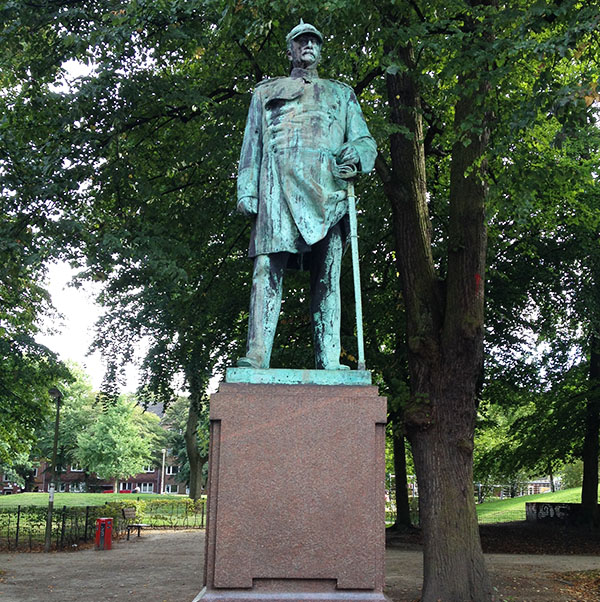
Contested: another of Hamburg’s Bismarck memorials, after cleaning. Klaus Neumann
By far the largest of Hamburg’s Bismarck statues, and the best known nationally, sits on the edge of the red light district of St Pauli and overlooks the river Elbe. Made of one hundred blocks of granite, it is more than thirty-four metres high and weighs more than 600 tonnes. Unveiled in 1906 after three years’ construction, it depicts Bismarck as a medieval knight holding a sword. It was listed on the cultural heritage register in 1960.
The monument has long been the focus of protests. It attracted controversy even during the planning phase. Sculptor Hugo Lederer and architect Johann Emil Schaudt’s design was criticised for portraying a seemingly unapproachable leader, prompting art historian Aby Warburg to deride its critics as anti-modernists. In the latter years of the Weimar Republic, German nationalists who celebrated Bismarck’s birthday at the memorial regularly clashed with left-wing demonstrators. In 1990, on the day of German reunification, unknown climbers covered Bismarck’s head with a Helmut Kohl mask, which inspired Stephanie Bart’s 2009 novel Goodbye Bismarck. In 2015, the monument was repurposed for another ephemeral work of art, “Capricorn Two,” when an ibex was mounted on Bismarck’s head.
When the Black Lives Matter movement took hold in Germany, Bismarck memorials were among its first targets. On 14 June, a week after Colston’s statue was dumped in Bristol Harbour, activists daubed one of the smaller Bismarck statues in Hamburg with red paint. The larger statue was spared the same fate only because it was concealed behind fences and scaffolding. In 2014, the federal government budgeted €6.5 million to restore the crumbling memorial, with the proviso that the state government match that amount to rebuild the surrounding park. Later, the overall amount budgeted for memorial and park was increased to €15.4 million. It was ironic that work on the monument began shortly before the repercussions of George Floyd’s killing reached Germany.
The decision to spend so much on restoring the Bismarck monument attracted criticism well before May 2020. Since January, a group that calls itself Intervention Bismarck-Denkmal has demanded via Twitter that the renovation work stop immediately. But the criticism was amplified following Floyd’s death, with new groups, such as Bismarck’s Critical Neighbours, adding their voice. When demonstrators demanded a halt to the project on 28 June, the Social Democrats and Greens, who have been in power in Hamburg since 2015, found themselves in a quandary. They were committed to restoring the monument but didn’t want to be seen defending what it was increasingly associated with: colonialism and racism. The state government therefore proposed to hold consultations to determine how the site could be repurposed without removing the monument. (They will kick off this Thursday, 19 November, with an online panel discussion, “Recontextualising Bismarck.”)
Proposals advanced thus far include a memorial museum inside the base of the monument to document Hamburg’s colonial past, and a counter-memorial adjacent to the statue. A Hamburg precedent exists for the latter: in 1982, rather than removing a controversial war memorial in the centre of the city, the state government commissioned the Austrian artist Alfred Hrdlicka to create a counter-memorial right next to it. Ideas less likely to be adopted include turning Bismarck on his head or replacing his granite sword with an illuminated Star Wars–type lightsabre.
Are the unnaming of Emily Ruete Square and demands for the removal of Bismarck statues evidence that Germany is heading towards an Orwellian dystopia where anything not deemed politically correct will be suppressed? No — if only because the “cancel culture” has been accompanied by loud protests (such as Iken’s) and authorities haven’t rushed to get rid of street names honouring the slave trader Schimmelmann or the opportunist Gründgens.
Prominent in the debate about what to do with the hundreds of Bismarck memorials in Germany is opposition to any form of Black Lives Matter–inspired iconoclasm. More often than not, the defenders of the monuments have spoken out against iconoclasm as such, rather than in defence of Bismarck as a historical figure. But that is likely to reflect strategic choices rather than any kind of censorship.
Iken and others nevertheless have a point. During the district assembly committee’s debate, Free Democrat Lars Jessen said he was “astonished” by the proposal to unname Emily Ruete Square because it was “incomprehensible” that Ruete’s views had only now become known. But the issue is not so much that the Greens and Social Democrats belatedly discovered Ruete’s racism; it’s that they didn’t care to engage with her life before suggesting a square be named after her.
Ruete’s 1886 memoir was reissued in 1989, accompanied by an editorial essay that contextualises her text, and republished by different publishers in 1998, 2007 and 2013. It is still in print and is available in several Hamburg libraries. I suspect the fact that Ruete was a woman of colour in nineteenth-century Germany was considered sufficient grounds for honouring her — in the same way that, a year later, her comments about slavery were sufficient grounds to withdraw the honour.
The complexity that makes Ruete such an intriguing historical figure has been in plain view, but was recognised only briefly during the discussions about the square. This complexity has not yet received the attention it warrants. Once the history workshop had produced evidence of her views about slavery and Black Africans, other aspects of her persona no longer mattered. Yes, she was an apologist for slavery. But she was also an astute observer of the hypocritical stance of European humanitarians in Zanzibar. She had only contempt for the British anti-slavery campaigners who took no interest in the welfare of people who had been freed: at best, she commented sarcastically in her memoir, European humanitarians were knitting woollen socks for the former slaves.
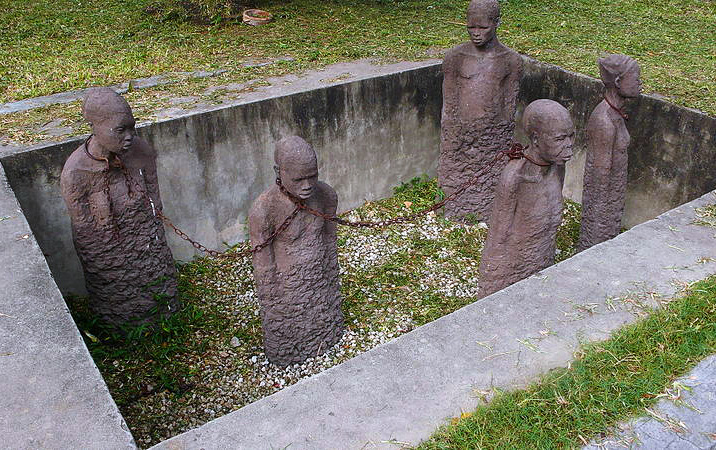
Complications: the Monument to Slaves in Stone Town, Zanzibar. Wikimedia
That it is possible to engage with Ruete while criticising her views on slavery and her role as a slave owner was demonstrated in 2009, when the Hamburg-based artist HM Jokinen created the performance “An Maria Ernestina,” an artistic intervention designed to disrupt the exhibition about Ruete at the Hamburg town hall. “I welcome the exhibition about Sayyida Salme, daughter of a slave,” the artist wrote at the time. “But I reject the honouring of a princess who accepted as normal the services of slaves and who profited from them.”
Ruete was also a perceptive observer of racism in Germany and the colonial gaze to which she herself was subjected: “At social events, in the theatre and at concerts, I had the feeling that I was constantly being looked at — something that I found most annoying,” she recalled in her second book, Briefe nach der Heimat. “One day, as my husband and I were out for a stroll, a couple of ladies in an equipage went by. Not only did they stare at us when they went past; but, when I accidentally turned around, I noticed the two ladies kneeling on the back seat in order to be able to observe us more closely.”
It is telling that the first German edition of Briefe nach der Heimat, in which Ruete writes about the first years of her life in Germany, was published only in 1999, six years after its English translation, and has never been reissued. Doesn’t the unnaming of Emily Ruete Square also perpetuate the silencing of Ruete’s critical views about Hamburg society?
I too have misgivings about the readiness with which Emily Ruete Square was unnamed, but mine are different from those articulated by Matthias Iken and aren’t specific to memorials tainted by Hamburg’s colonial past. Germany is still a country of perpetrators, accomplices, bystanders and their direct descendants. Memorialising the lives of the victims of Nazi Germany (or of German colonialism, for that matter) while removing from public view any references to the lives of perpetrators, accomplices and bystanders risks obscuring that fact.
Over the past twenty-eight years, the artist Gunter Demnig has laid more than 75,000 Stolpersteine (“stumbling stones”): concrete cubes with brass plates inscribed with the name of a victim of Nazi persecution. The overwhelming majority of Stolpersteine are in Germany. This is undoubtedly an effective means of helping Germans to remember the Holocaust and honour the many ordinary people who became its victims, but shouldn’t Germans also be compelled to stumble across the names of perpetrators and accomplices, lest the complicity of ordinary Germans is forgotten?
Or, as I proposed some twenty years ago, might it not be appropriate for Hamburg residents to perform a public reading not only of the names of the thousands of Hamburg Jews who were killed in the Holocaust but also of the names in the 1943 Adressbuch, the last directory of all the heads of all households registered in Hamburg, which was published during the second world war?
Bismarck is in good company. Other historical figures — Immanuel Kant among them — have been exposed as apologists for colonialism or as racists. Postcolonial and anti-racist iconoclasts would be very busy indeed if we decided to no longer commemorate the lives of individuals who used the “n” word, denigrated people of colour or were implicated in German colonial ventures. Which is not to say that Kant’s writings about “races,” for example, don’t deserve more critical attention than they have received thus far.
Nor are the demands to raze controversial memorials unprecedented. After 1989, East Germans were often only too ready to expunge all traces of the German Democratic Republic by renaming streets and schools and removing memorials. Sometimes the desire to draw a line under the past even led to the targeting of people like Karl Marx, Rosa Luxemburg and the cosmonaut Yuri Gagarin, who happened to be communists but who could not be held responsible for Stalinist repression. With the benefit of hindsight, it is obvious that attempts to expunge all references to East Germany’s communist regime have been counterproductive and ill-conceived.
But when it comes to German debates about memorials today, I don’t see a cancel culture at work. Rather, I detect attempts to neutralise, if not sanitise, the past. Complementing a restored and cleaned-up Bismarck monument with an exhibition about Hamburg’s colonial past and with a counter-memorial, however worthy that may be in itself, could encourage Hamburg residents to wash their hands of the legacies of colonialism. Rather than letting the past intrude into the present, a counter-memorial on its own might put the past to rest. But the thirty-four-metre high Bismarck monument would stand in the way of such memorial hygiene.
Sure, it could be regarded as an eyesore. But because it is so monumental and ugly, it can’t be easily ignored. It could therefore serve as an awkward reminder of Germany’s dark pasts, and their legacies and continuation into the present. Something like that happened in 2004–05 when the Wissmann statue, which had been put into storage in 1968, was re-erected for fourteen months in the context of HM Jokinen’s afrika-hamburg.de art project.
Like the Hamburg war memorial, whose message was meant to be neutralised by Hrdlicka’s counter-memorial, the granite Bismarck should remain a beacon for protests and a canvas for graffiti and other ephemeral art, notwithstanding any adjacent counter-memorial. Let’s hope that the authorities don’t take the view that a counter-memorial is a substitute for anti-memorial graffiti and that the statue therefore needs to be kept spotlessly clean.
The Hrdlicka memorial is not enough to counter Hamburg’s most obnoxious war memorial: traces of red paint, and of countless attempts to remove that paint, have done at least as much to call the war memorial’s raison d’être into question. The head of the district of Hamburg-Altona, which is responsible for one of the smaller Bismarck statues, had a good point when she announced after it was defaced that council workers were not expected to clean it up immediately.
Bismarck has been a controversial historical figure not only because of his role in German colonialism but also because he was an anti-democrat, because he tried to repress the organised labour movement and because of his anti-Semitism. He was also the founder of Germany as a political entity. Critically engaging with his memory could prompt a reassessment not just of the kind of aggressive nineteenth-century nationalism that informed the 1870–71 Franco-Prussian war, which led to the unification of Germany, but also of the idea of the nation that suffuses today’s understanding of what it means to be German.
I hope the Bismarck colossus overlooking the river Elbe will stick around to catalyse discussions that go beyond a distancing from recognisably dark pasts and instead engage with seemingly unproblematic presents. I also hope that closer attention to the experiences of Emily Ruete will facilitate a public conversation about everyday racism and the lives of people of colour in Hamburg, be it in the late nineteenth or in the early twenty-first century.
Some weeks ago, the state archives created a new position to investigate the colonial dimensions of street names in Hamburg. Obviously the authorities are hoping to avoid in future the kind of embarrassment that was caused by the naming of Emily Ruete Square. But what might actually be needed to get people in Hamburg to engage with the complexity that made Ruete such an intriguing historical figure is a (non-official) effort to rename that square in Hamburg-Nord. •
